Schedule a Call
Get started with your organic growth journey!



Get insights on AI, productivity, and the future of work.



A construction business runs on trust, expertise, and the ability to execute flawlessly, values that must be communicated to the right audience. The secret is that marketing attracts attention and builds a reputation that turns fleeting interest into long-term success.
The most effective strategies tell a story of who you are, why you stand out, and how you turn one-time projects into ongoing partnerships.
For construction companies, it’s essential to become the first choice for clients who are ready to invest in a partner they can trust. With the right marketing, your business is remembered, respected, and sought after. Keep reading to learn how the best marketing strategies can make this happen for you.
Effective marketing requires a mix of branding, digital visibility, and relationship-building, all aimed at making your company the trusted choice in a competitive market.
When marketing to B2B clients like general contractors, developers, or public agencies, your focus is on proving your ability to handle large-scale, high-stakes projects. For B2C clients, such as homeowners or remodelers, the key lies in building personal trust and demonstrating the value of your craftsmanship.
The Construction Marketing Funnel is a simple yet powerful way to map out the client journey:
While this funnel may seem straightforward, executing it effectively requires expertise. At every stage, there’s an opportunity to build trust, prove your value, and differentiate your company from competitors.
As one contractor on Reddit shared, ‘I spent over $7,000 on marketing and didn’t land a single job.’ This experience is not uncommon for many in the construction industry.
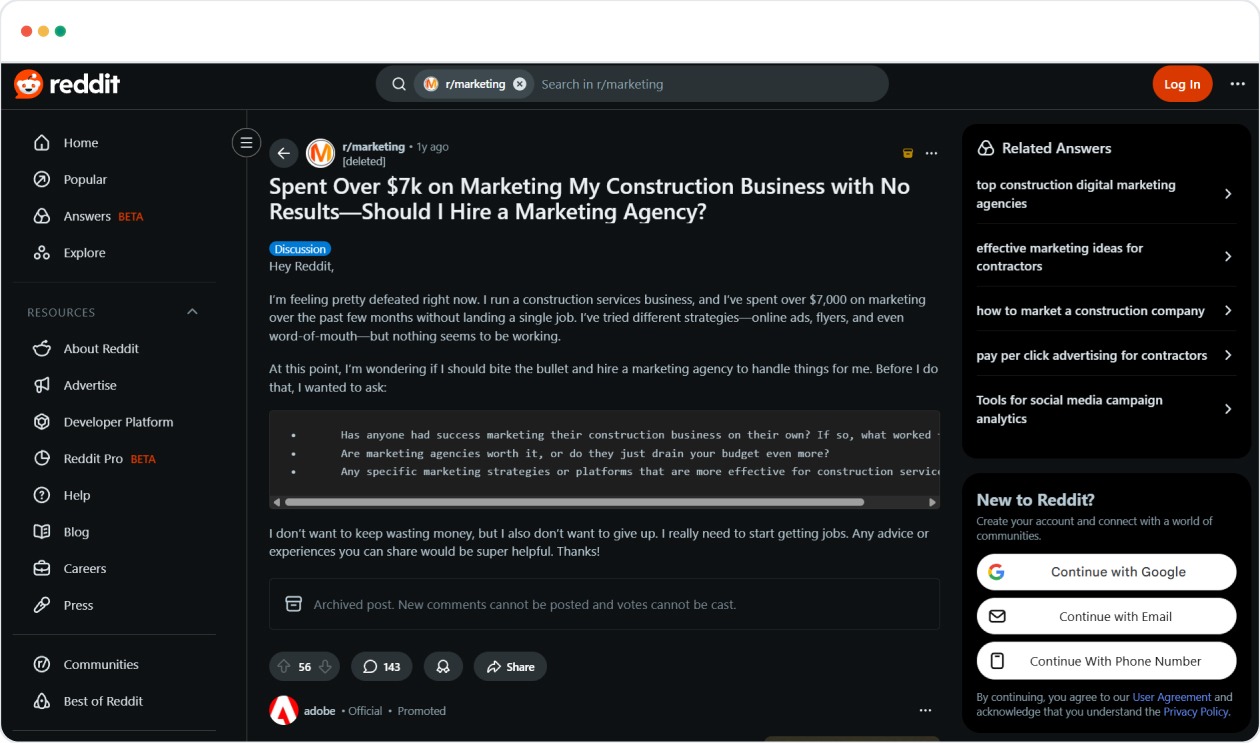
Without a strategic approach, marketing efforts often fail to convert into tangible results. The key is to fine-tune your content and SEO strategy to make sure your efforts hit the right target, every time.
Marketing your construction business is about creating a strategic approach that builds trust, attracts the right clients, and sets you apart from competitors.
Here are 13 expert-level strategies that will transform the way you approach marketing and help you win more projects, build lasting relationships, and establish your company as a leader in the field.
Your business grows when you know exactly who you're serving. Residential, commercial, industrial, or public infrastructure; these are entire worlds of distinct needs and challenges. Trying to be everything to everyone dilutes your message and weakens your brand.
When your niche is clear, your marketing follows suit, leading to stronger, more targeted client relationships.
Your brand is the foundation of everything you do. It’s about your company’s reputation, values, and what sets you apart from every other contractor in the market.
Building a strong, differentiated brand is a strategic move that requires expert execution.
Your website needs to be a powerful tool that generates leads while showcasing your expertise.
A well-optimized website requires ongoing attention to make sure it stays relevant and high-converting.
SEO is essential for construction companies looking to stay visible. You need to show up when potential clients type in "construction company near me."

Getting SEO right is a commitment to improving your digital footprint every day.
In construction, your reputation can make or break you. To attract more clients, you need to showcase the great work you’ve already done.

However, a good reputation and positive reviews solve most of these challenges, as more people are eager to work with someone who is trusted and highly recommended.
Building a strong online reputation takes time and consistency; it's a process that requires ongoing attention.
Content is a way to demonstrate your expertise. In the construction industry, it’s about providing value that resonates with your target clients.
Great content requires strategy and expertise in both creation and distribution.
Social media is a powerful tool for showing what you do best. It’s for building a story that clients can connect with.
Visual storytelling takes careful thought, planning, and execution.
Paid ads are an investment in visibility. Targeted advertising ensures that your message reaches the right audience at the right time.
Leads don’t always convert right away, and that’s where nurturing comes in. By staying top of mind, you increase the chances of turning a cold lead into a loyal client.
Nurturing is about building a relationship through thoughtful, consistent communication.
Great marketing is about relationships, and some of the best opportunities come from strategic partnerships and referrals.
Networking is about nurturing relationships that can lead to meaningful business growth.
Trade shows and local events provide invaluable opportunities to meet face-to-face with your target clients and showcase your expertise.
In-person marketing requires preparation, authenticity, and the ability to engage potential clients on the spot.
Technology makes marketing more efficient, but it also adds clarity and organization to your efforts. Without the right tools, you risk missing out on valuable opportunities.
A CRM and simple analytics tools give you the insights you need to improve your marketing strategy continually.
In a competitive industry, innovation and sustainability can set you apart. Clients increasingly look for contractors who prioritize eco-friendly practices and innovative technologies.
Sustainability is a competitive advantage that requires genuine expertise to implement effectively.
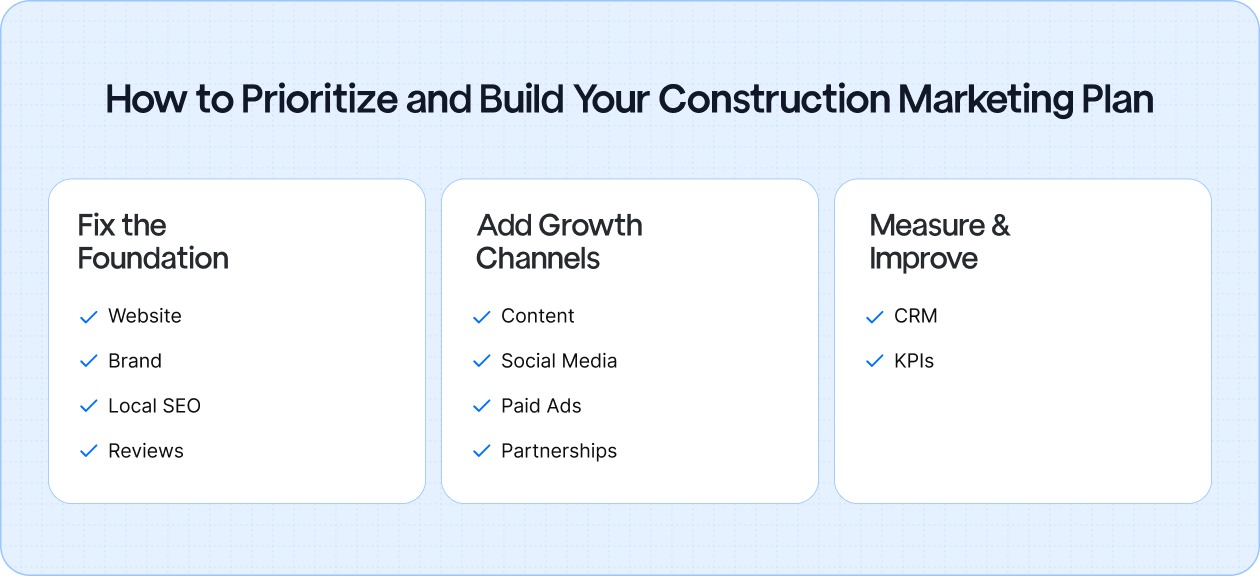
Building a successful marketing plan for your construction business is about focusing on the essentials that will deliver lasting results. Consider you’ve laid the foundation of a solid structure, but if you don’t pay attention to the next steps, that structure will crumble.
The same goes for your marketing plan. Here's how to build it step by step:
Before you can even think about growth, your business needs a strong foundation. This is the core of your marketing strategy, the elements that will carry your message and make you stand out in a competitive market.
Getting these elements right requires careful planning and execution. It’s not something that needs ongoing attention.
Once your foundation is set, it’s time to scale. The next step is about expanding your reach and connecting with clients at every stage of their journey.
These channels are powerful, but to be truly effective, they need to be managed carefully by someone who understands how to leverage each one for maximum impact. Trying to juggle them on your own can quickly become overwhelming.
You can’t improve what you don’t measure. The final step is about tracking your results, learning from them, and optimizing as you go.
Regularly reviewing these metrics will help you understand what’s working and what isn’t. Optimization is a continuous process that requires attention to detail.
Building a marketing plan is an ongoing project, and it’s best done by someone who understands the nuances of the construction industry and digital marketing.
Your marketing efforts are an investment, and like any investment, it’s essential to measure the return. Without the right metrics, it’s easy to lose track of what’s working and what’s not.
KPIs (Key Performance Indicators) help you see where your marketing stands, providing clarity on how each tactic is performing and guiding you toward more profitable decisions.
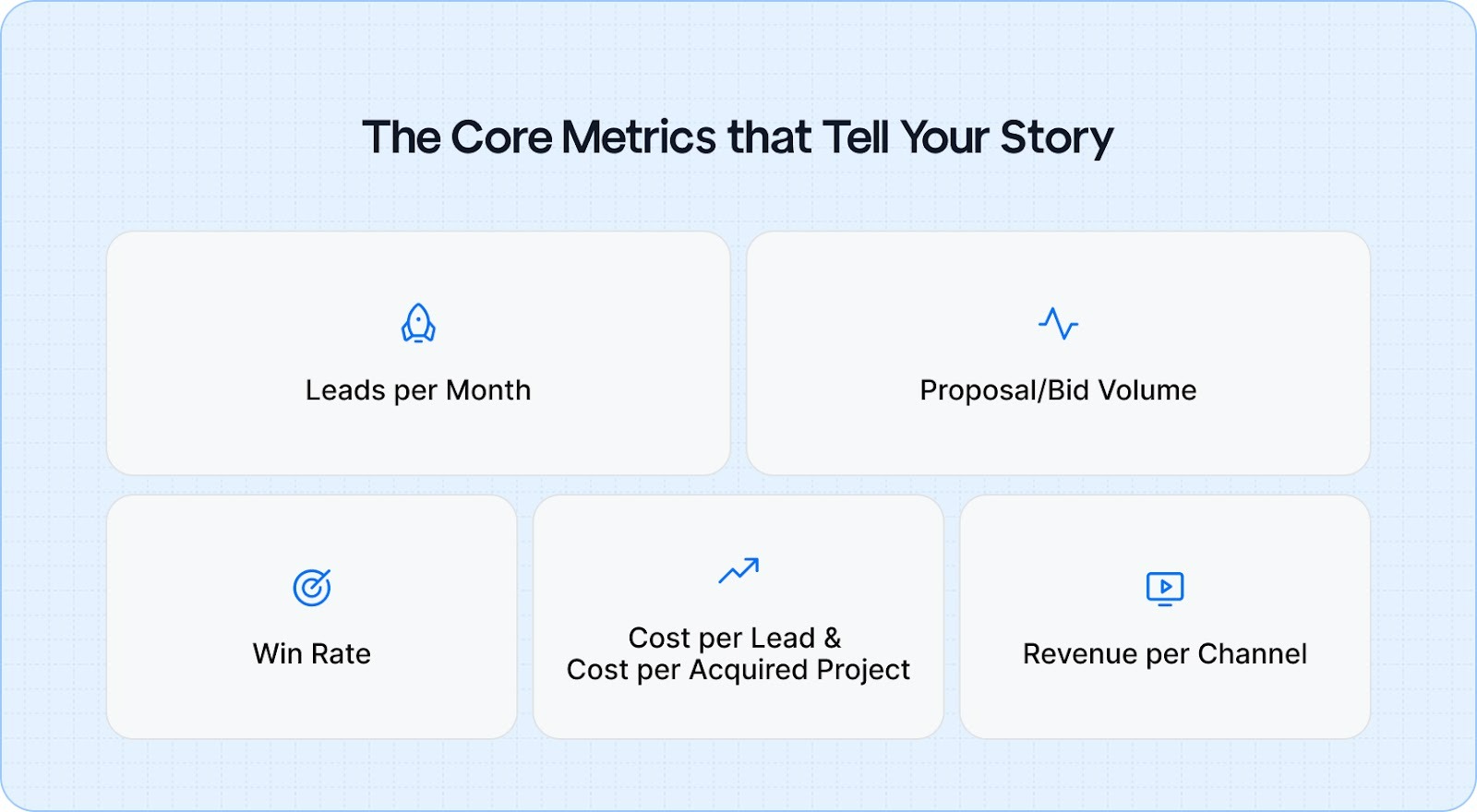
To understand if your marketing is effective, focus on the metrics that matter most:
To get a clear picture of how well your marketing is working, calculate your Marketing ROI. This formula shows how much profit you’re earning for every dollar spent on marketing:

A high ROI means your efforts are paying off. A low ROI signals it’s time to reassess and optimize.
It’s easy to get caught up in the day-to-day, but regularly reviewing your KPIs ensures your strategy stays on track. Every quarter, take the time to evaluate how your marketing is performing:
This process of pruning, cutting back on what’s not working, ensures your marketing dollars are spent wisely, and your strategy evolves to meet your business goals.
As a creator of spaces, your work speaks for itself. But in today’s competitive market, how you tell that story matters just as much. Your marketing is about building relationships, earning trust, and ensuring your brand is seen as synonymous with quality and reliability.
A compelling website, a strategic social media presence, and client referrals all play a role in shaping how potential clients perceive you.
By weaving these strategies into your day-to-day efforts, you’re building a legacy. A legacy that endures because your name becomes associated with innovation, excellence, and a commitment to delivering results. Consistency in your marketing efforts secures your place as a trusted partner for years to come.
A1: The best marketing strategies for the construction industry include defining a clear niche, building a strong brand, optimizing your website for lead generation, and leveraging SEO. Additionally, focusing on case studies, social media engagement, and building strategic partnerships can help elevate your brand and attract more clients.
A2: To get more clients, focus on building strong relationships, optimizing your website for SEO, leveraging social media to showcase past projects, and asking for client referrals. Participating in trade shows and partnering with other industry professionals can also expand your reach and generate new leads.
A3: SEO is crucial for increasing online visibility and driving traffic to your website. By optimizing for relevant local keywords and building location-specific landing pages, your construction business can appear at the top of search results, attracting more potential clients who are actively searching for your services.
A4: Building a strong brand involves clarifying your business values, consistently communicating your unique selling points (USPs), and presenting a professional image across all touchpoints. This includes your website, social media, proposals, and signage. Highlight your achievements, certifications, and successful projects to build trust and credibility.
A5: Yes, content marketing is highly effective for construction companies. By creating valuable content, such as blogs, case studies, and project showcases, you can position yourself as an expert, engage potential clients, and improve your SEO rankings. It helps build trust and attracts quality leads to your business.
A6: Reviews and testimonials are extremely important in construction marketing. Positive feedback from past clients serves as powerful social proof and builds trust with potential clients. Systematizing review requests and showcasing them on your website, social media, and proposals can significantly impact your ability to win new projects.
A7: The success of construction marketing can be measured by tracking key performance indicators (KPIs) such as leads per month, proposal volume, win rate, cost per lead, and revenue per channel. Regularly reviewing these metrics will help you refine your strategy and ensure you're focusing on the most effective marketing tactics.

When you're focused on delivering quality work and running your business, getting noticed online can often take a backseat. But with so many people searching for services like yours, your business must show up when it matters most.
Contractor SEO is the solution to this challenge. It’s the practice of optimizing your website so that it ranks higher on search engines, making it easier for potential clients to find you. SEO is about ensuring your business is visible to those who need your services.
This guide will walk you through the key steps of contractor SEO and how to use it to connect with more clients and grow your business.
Getting noticed online is crucial for growing your business, and that’s where contractor SEO comes in. When someone needs your services, they’re likely to search online for a solution. But what happens if your business doesn’t show up in search results? You miss out on the opportunity to connect with potential clients.
Contractor SEO is a strategy that helps your website appear when people search for services like yours. It's about making sure your business is visible and easy to find. Here’s a breakdown of how it works:
While SEO might seem a bit complex, it’s essentially about making your business easier to find online.
And while you can manage some aspects of SEO yourself, getting the details right often requires an expert touch to ensure you're maximizing your reach and connecting with the right clients.
When it comes to growing your contractor business, getting noticed online is as important as delivering excellent service.
But how can you ensure potential clients find you when they search for services like yours? That’s where SEO comes into play, helping you rise above the competition and attract the right clients.
Here’s how SEO can make a real difference for your business:
While these results sound straightforward, achieving them requires a deep understanding of SEO and constant optimization. That’s why having the right tools and expertise to guide your efforts can make a world of difference, ensuring everything works seamlessly to help your business stand out and grow.
Local SEO is one of the most powerful ways to ensure your business is visible when potential clients near you are searching for services.
It’s all about making sure your business appears at the top of search results for local queries, such as “contractor near me” or “plumber in [your city].”
Here's how to master local SEO:
Ensure all details are accurate and up-to-date, and encourage clients to leave reviews.
Local Listings and Directories: Get listed on local directories like Yelp, Angi, and others. These platforms increase your credibility and help you reach more potential customers in your area.

When potential clients visit your website, do they find what they’re looking for easily? Or do they leave frustrated, unable to navigate or find relevant information? To turn visitors into clients, your website needs to be optimized for both search engines and users.
Here’s how to ensure your site is ready to convert:

Website performance is a crucial aspect of SEO. A slow, insecure, or difficult-to-use website can drive potential clients away, even if you have the right keywords. Here’s how to make sure your website is ready to impress:

As a contractor, your reputation is everything. How do you show potential clients that you're reliable, experienced, and the best choice for the job? Building trust and authority online is a key part of this process. Here's how to make it happen:
This boosts your rankings and enhances your authority in your field. The more quality backlinks you have, the stronger your site’s authority becomes.
These reviews improve your reputation and help you rank higher in search results, making it easier for new clients to find you.

One of the best ways to attract new clients and build trust is by showcasing your expertise through content. It’s about offering value that answers the questions potential clients are searching for. Here’s how content marketing can help you stand out:
By offering valuable insights, you establish yourself as an authority in your field, making it easier for clients to trust you with their projects.
Video Content: Videos are a powerful way to connect with clients. Showcasing your work on a project, sharing client testimonials, and explaining your process through video helps potential customers see your expertise in action.

Once you've implemented your SEO strategy, it's important to track how well it's working. You can't improve what you can't measure, so here’s how to monitor your progress and adjust your approach:

When it comes to SEO, there are two main paths you can take: doing it yourself or partnering with a platform that specializes in streamlining the process.
Both options have their advantages, depending on your goals and the time you can invest. Here’s a breakdown:
The platform enhances your website’s visibility using AI-driven tools, ensuring you reach the right audience at the right time.
With Gushwork’s intuitive leadership dashboards, you can monitor your SEO performance in real-time and make data-driven decisions for long-term growth. Their expertise and advanced tools help you manage your SEO efforts more effectively, so you can stay ahead of the competition without getting bogged down in the details.
One contractor shared on Reddit that after $7k in marketing spend, they’d received zero jobs, highlighting the risk of simply ‘doing digital’ without a strategy.
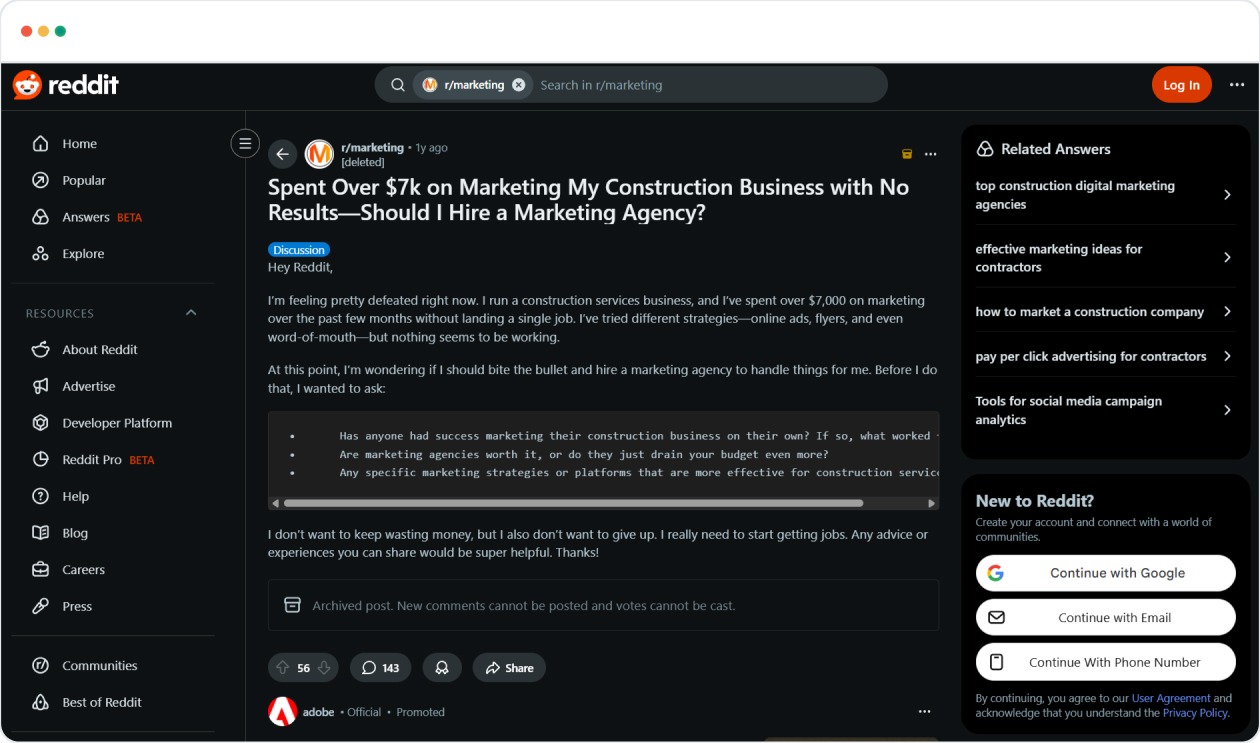
Poor implementation and lack of strategy in digital marketing can lead to wasted spend, especially in the contracting business.

SEO is the foundation of your online presence; without it, you’re missing out on clients who are actively searching for the services you provide. A well-optimized website doesn’t just increase your visibility; it transforms online visitors into loyal clients. If you're starting with SEO or refining an existing strategy, it’s never too late to take control and make your website work for you.
You’ve already learned the essentials of contractor SEO, from local optimization to content marketing and technical improvements. But turning those insights into real, measurable results can be complex.
This is where expert guidance makes a difference. With the right strategy, you can scale your efforts, improve your rankings, and start attracting more clients.
A1. Contractor SEO means optimizing a website specifically for service businesses (like contractors) so that when someone in your area searches for a job you do, your business shows up. Unlike general SEO, which may focus on many industries and broad keywords, contractor SEO zeroes in on local service keywords (e.g., “roofing repair [city]”), service pages, local listings, reviews, and mobile experience that matter when someone needs help quickly.
A2. There’s no fixed timeframe. Often you’ll see some positive movement within 3‑6 months, but meaningful results (like consistent visibility and more calls) may take 6‑12 months or more. The timeline depends on your website’s starting point, competition in your local market, how thoroughly you optimise things (local listings, website structure, content, reviews, backlinks), and how quickly you act on it. Realistic expectations help avoid frustration.
A3. Yes, you can do much of it yourself, especially the basics like making sure you have a complete local business profile and good service pages. But some parts are tricky and time‑consuming (technical site issues, strong link‑building, keyword strategy). Getting an expert or a platform can help you avoid costly mistakes, make sure everything works together, and scale things more efficiently.
A4. Very important. When your business listing (e.g., Google Business Profile) shows up with good reviews and accurate info (name, address, phone), people are more likely to trust you and click. Local listings also help search engines understand where you operate and what you offer. Think of reviews as “proof” you’ve done good work, and listings as your local directory presence.
A5. Start with keywords that a potential local client might type when they need your service, such as “emergency plumbing [city]”, “roof replacement [suburb]”, or “kitchen remodeler near me”. Then branch into longer phrases (“how much does a roof replacement cost in [city]”).
Target a mix of service + location keywords and questions people ask. Use tools or expert help to find which ones have good search volume but aren’t overly competitive in your area.
A6. Here are key items:
These factors help both users and search engines, which increases your chance of ranking.
A7. You track a few core things:
When you monitor these metrics monthly, you’ll know if your efforts are paying off or need adjustment.
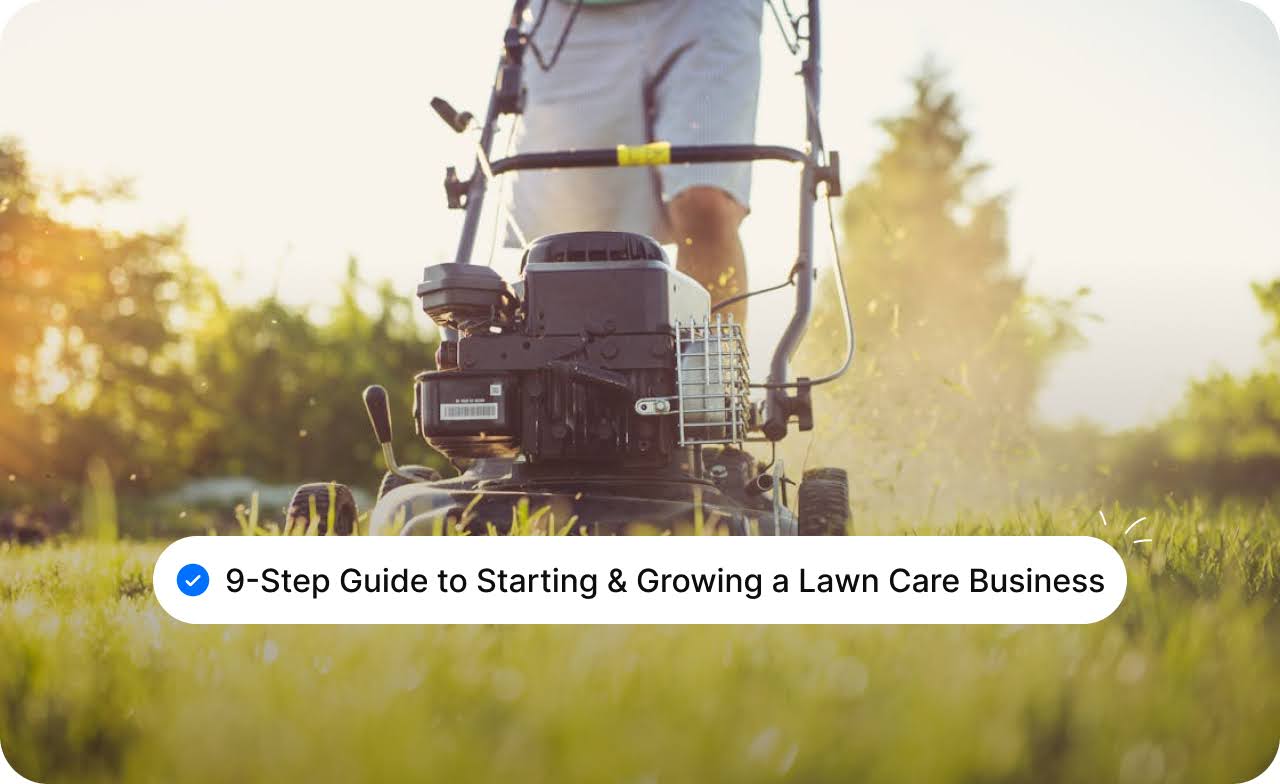
Starting a lawn care business is an exciting opportunity to turn your love for working outdoors into a profitable venture.
With minimal startup costs and a steady demand for services, it’s a business model that’s accessible to almost anyone. If you plan to operate solo or grow into a full-fledged company, learning how to start a lawn care business requires understanding the right equipment, setting competitive prices, and attracting your first customers.
This guide will walk you through each step, breaking down everything you need to know in simple, easy-to-understand terms. Let’s dive into the process and set you up for success.
Starting a lawn care business offers an appealing opportunity for anyone looking to earn a steady income while working outdoors. It’s a business that doesn’t require huge upfront costs and has a consistent demand from homeowners and businesses alike.
You’ll find a constant need for lawn care services in both residential neighborhoods and commercial spaces. Plus, it’s a business you can easily scale, adding new services or employees as you grow. However, like any business, it’s not without its challenges.
There are seasonal changes to consider, competition to outpace, and the physical demands of the work itself. But for those willing to put in the effort, the rewards can be significant.
In the end, the pros often outweigh the cons for those ready to put in the work, especially since the lawn care industry offers so many ways to grow and expand.
When starting a lawn care business, the most important step is gaining hands-on experience. While having the right equipment is essential, your skills will be what truly sets you apart. Getting familiar with the various tasks involved, from mowing and trimming to fertilizing and pest control, is crucial.
If you’re new to the field, consider starting small by offering services to friends or family at discounted rates. This allows you to practice, improve, and build a real-world portfolio.
Alternatively, working for an established lawn care company for a while can provide valuable on-the-job learning.
Here are the key skills you need:
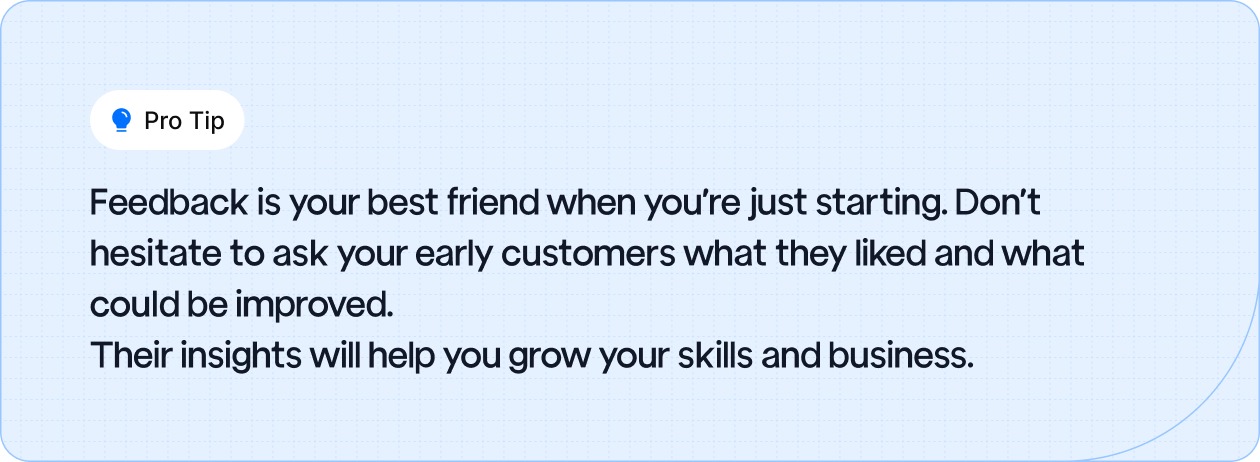
Once you’ve built the foundational skills, it’s time to make things official. To operate legally, you’ll need to follow specific steps, such as registering your business, obtaining the right licenses, and getting insured.
These steps protect you and help you present a professional and trustworthy image to your clients.
Here’s what you’ll need to cover:
The legal side of things is crucial, but how you present your business to the public is just as important. A well-crafted website, engaging content, and SEO are essential for standing out and attracting clients.
A business plan is your roadmap to success. It guides you in setting realistic goals, determining your pricing, and outlining your services.
A solid business plan also helps you stay organized, manage your finances, and keep track of your growth.
Here's what you need to include:

Your equipment is the backbone of your lawn care business, but that doesn’t mean you need to spend a fortune up front. Start with the basics and grow your toolkit as your business expands.
Here’s the essential gear you’ll need to start:

When it comes to pricing, you need to strike the right balance between competitive pricing and profitability. To get started, research what other businesses in your area are charging, then adjust for your experience and the value you offer.
Here’s how you can structure your services:
Check out this quick video for valuable tips on launching and growing your lawn care business, perfect for getting started!
(Embed the video here)

Marketing is about creating a brand that resonates with potential customers and building an online presence that makes you stand out. A well-crafted marketing plan will help you build trust, attract leads, and turn them into loyal clients.
Here’s how you can market effectively:

As your lawn care business gains traction, you’ll need to scale to meet the growing demand. Hiring employees or subcontracting work can help you manage larger jobs.
Expanding your services, such as adding landscaping or pest control, will also attract more clients and increase revenue.
Here’s how to scale effectively:

Consistently delivering high-quality work is the key to retaining customers and encouraging referrals. Your reputation depends on reliability, punctuality, and excellent customer service.
Here’s how you can maintain high standards:
Tracking your finances properly is essential for keeping your business profitable. Use accounting software to stay on top of your expenses and revenue, and be mindful of the taxes you’ll need to pay.
Here’s what to keep in mind:
You’ve learned the essential steps to get your lawn care business up and running, gaining hands-on experience, mastering key skills, navigating legalities, and crafting a solid business plan.
You now know how to market your services, scale your operations, and maintain the high standards that will keep customers coming back. The groundwork is laid, and the next step is yours to take.
Starting your lawn care business is possible with the right approach, and it can be incredibly rewarding. As you take these steps, remember that a strong foundation combined with ongoing strategic growth will set you up for long-term success.
Now that you have the knowledge and the tools, it’s time to put your plan into action!
A1. The initial investment can vary widely depending on your location and scale. For a solo operation, you might start with a push mower, trimmer, blower and basic transport; costs may run a few hundred to a few thousand dollars. As you scale (truck/trailer, commercial mower, more crew), costs can rise into the tens of thousands.
A2. Yes, it depends on your region and the services you plan to offer. Basic business registration is almost always required. If you apply fertilisers, pesticides or provide certain commercial services, you may need additional certifications or permits.
A3. Consider your local market, your overhead (equipment, fuel, labour), job complexity and square footage. Hourly makes sense for uncertain jobs; flat‑rate or tiered packages allow predictability for you and your customer. Research what competitors charge in your area.
A4. Begin with high‑demand, lower‑complexity services like mowing, edging and basic trimming. Once you have a stable client base, you can add higher‑margin services such as aeration, fertilisation, pest control or commercial contracts. This allows you to manage risks and build quality first.
A5. Start locally: knock on doors, distribute flyers or door‑hangers in target neighbourhoods, list your business in local directories and ask for referrals from early clients. Show clear value (before/after photos help). As you grow, build an online presence (Google Business Profile, social media) and collect positive reviews.
A6. Some common challenges: seasonality (especially in cold climates), heavy physical labour, competition and equipment costs/maintenance. Mitigate by offering off‑season services, keeping equipment well‑maintained, differentiating your brand, and budgeting for slower periods in your business plan.
A7. Extremely important. Many customers search online for “lawn care near me” and compare options. A professional website, good content (explaining services, showing results), and local SEO help you appear credible and attract leads. Even if you focus on local neighborhoods, digital visibility can make the difference between being found and being overlooked.

As a roofing company, your success depends on being visible to local homeowners when they need you most. More and more people are turning to online search to find roofing services in their area, which means if your business isn’t showing up in these local search results, you’re missing out on key opportunities.
Local SEO is essential for boosting your online visibility, ensuring you appear at the top of search results when homeowners search for roofing services near them.
In this blog, we’ll cover actionable local SEO roofing tips to help your roofing business rank higher, attract more local leads, and grow your customer base.
When we talk about “seo roofing”, we’re talking about the smart steps a roofing company takes so that when someone Googles a roofer nearby, your business shows up first.
Think of SEO, search engine optimization, as your roofing business’s digital “open for business” sign.
Here’s a simple breakdown of what it means:

SEO for roofing means you adjust your online presence so when someone needs your service right now, they find you, not your competitor. And once they find you, it’s your job to make it easy for them to contact you, and start the job.
If you’re a roofing business owner, you might be wondering: Why should I invest in SEO?
The answer is simple: SEO can bring in more leads, and ultimately grow your business.
Let’s break down the benefits so you can see how SEO can make a real difference for your roofing company:
SEO helps your roofing business rank higher in search results, making it easier for potential customers to find you when they need your services.
How SEO achieves this:
Local SEO ensures your roofing business is reachable to people in your area who are actively searching for roofing services.
How SEO achieves this:
SEO builds trust with both search engines and potential clients by improving your online presence and providing proof of your expertise.
How SEO achieves this:
Unlike traditional advertising, SEO works continuously to attract leads without ongoing costs for each new client.
How SEO achieves this:
SEO is an investment that pays off over time. As you continue to build and refine your SEO strategy, your roofing business will steadily gain traffic.
How SEO achieves this:
SEO helps you stay competitive by ensuring your roofing business ranks higher than others in your area.
How SEO achieves this:
To make sure your roofing business stays available on Google’s first page, it’s essential to implement best practices that align with its changes.
Ranking on the first page of Google is about following smart, consistent best practices that match how Google works today.
Especially for roofing businesses in Ohio, securing those top‑spots means doing the right things well. Below are proven practices you can apply now:
Your GBP is often the first thing a local homeowner sees. Getting it right boosts your online presence and trust.
Clients are searching for roofers in their city or neighborhood, so your website should speak exactly to them.
When users click your site, they should quickly see you’re professional and easy to work with.
Positive reviews and consistent directory listings tell Google you’re trusted and active in your community.
Content that answers common questions and reflects your service area helps you show up in more searches and stay relevant.
SEO needs regular monitoring and tweaks.
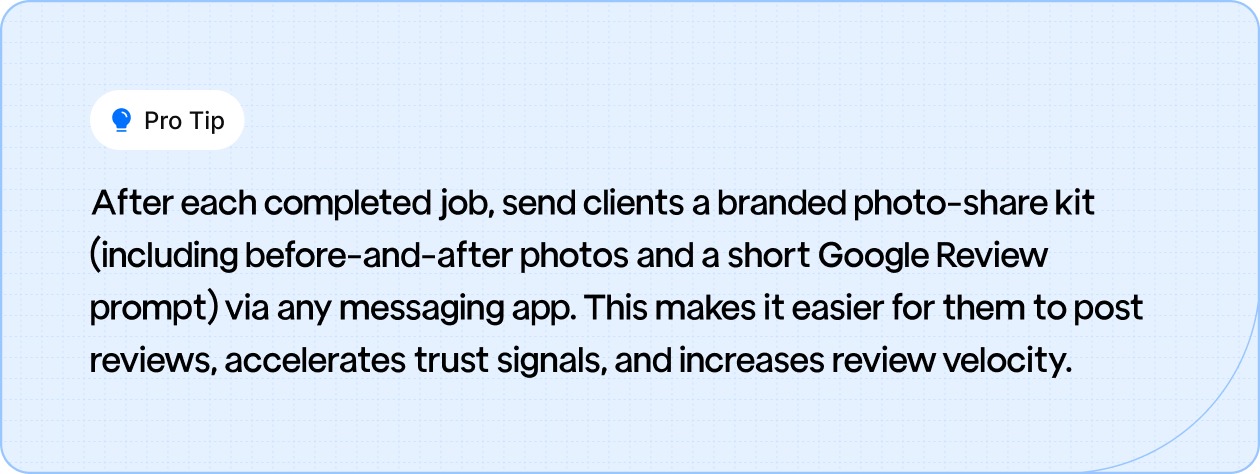
At the end of the day, homeowners don’t pull out directories, they pull out their phones. And when they do, you want your roofing business to be the one they call. By embracing local SEO strategies, you position yourself at the exact moment someone needs you most.
The competition is already showing up online. Make sure you do, too. The tools are available, and the opportunity is right in front of you. The only thing standing between your business and more local leads is action.
Let’s get your roofing company seen and booked. Contact us now!
To track your progress, use tools like Google Analytics, Google Search Console, and Google Business Profile insights to monitor website traffic, keyword rankings, and the number of calls or leads generated.
SEO is a long-term investment. Typically, you can start seeing significant results within 3 to 6 months, though it can take up to 12 months to see a full impact depending on competition.
A good review for a roofing company should be specific and detailed, such as mentioning the service provided (e.g., roof repair or replacement), the location, and a brief mention of customer satisfaction or the quality of work.
For roofing companies, local SEO is far more important because most customers will search for roofers in their immediate area. National SEO can be helpful if you plan to expand, but local SEO is crucial for attracting the right leads.
Yes, combining SEO with paid ads can be very effective. SEO provides long-term organic growth, while paid ads give immediate visibility. Together, they help maintain a consistent flow of leads while building your online presence over time.

In contracting businesses, delivering high-quality work is just part of the equation. The other half is making sure the right people know about your services, and that’s where digital marketing comes in.
A great reputation and flawless execution can go unnoticed if your business isn’t visible online. Digital marketing helps you stand out, attract the right leads, and build a reputation that keeps your phone ringing.
For contractors, the key is being present where potential clients are searching. With the right digital marketing strategies, you can grow your online presence, convert leads into clients, and build long-term business success.
In this blog, you’ll learn the key components of digital marketing and mistakes many contractors make in it, and how you can avoid them to grow your business smarter and faster.
Clients go online first, search for someone nearby, check reviews, compare quotes. If your business isn’t visible where they’re looking, you’re missing out.
Here are clear reasons why you should lean into digital marketing, with some insights tailored for contractors:
By embracing digital marketing, you’re setting your contracting business up in a better position, with more qualified leads, better trust, and a stronger future.
Let’s get into the key components that can help you get started and build a strong digital presence.
Digital marketing is a powerful tool to grow your business, attract local clients, and stand out from the competition. But with so many aspects to manage, it can be overwhelming to know where to start.
The good news is, by focusing on a few key components, you can create a solid foundation for your digital marketing efforts that will deliver real results.
Below are the main building blocks you should focus on.
Your website is your digital storefront. It needs to be:
For contractors, local SEO is the most important. Here’s what to do:
Beyond local SEO, you’ll want your website pages to be optimized so you show up when people search for your services. Important elements include:
Since SEO takes time, you can use paid advertising to get faster results:
Social media helps you build trust, showcase your work, and stay visible:
Reviews matter a lot. With many contractors vying for work, clients check ratings and reviews before they hire. Make sure you ask satisfied clients to leave reviews on Google, Yelp, or other relevant platforms. You can:

While implementing these components is crucial, it’s equally important to avoid common digital marketing mistakes that can slow down your progress.
As a contractor, digital marketing can offer immense growth opportunities, but it’s easy to fall into some common traps. These mistakes can waste your time, money, and effort. Here’s what to watch out for and how to fix them.
Mistake: Starting digital marketing without a clear, focused strategy can lead to wasted efforts and missed opportunities.
What Can You Do:
Mistake: Failing to optimize for local search means missing out on clients who are specifically looking for services in your area.
What Can You Do:

Mistake: A poorly designed or slow-loading website can drive potential clients away before they even contact you.
What Can You Do:
Mistake: Not optimizing for mobile users can lead to a frustrating experience for a large portion of your audience.
What Can You Do:
Mistake: Without reviews and testimonials, clients question your credibility and expertise.
What Can You Do:
Mistake: Without tracking results, it’s hard to know what’s working and where you need to improve.
What Can You Do:
Mistake: Relying solely on paid ads can be costly, and ignoring organic methods like SEO and content marketing can limit your long-term success.
What Can You Do:
Mistake: Letting your content go stale means missing the chance to engage with your audience and show you’re active.
What Can You Do:
By avoiding these mistakes and following these actionable solutions, you’ll maximize your digital marketing impact and build a stronger online presence that attracts more clients.
Gone are the days when a simple sign on the side of the road or a business card handed out at the local coffee shop was enough. Now, your future clients are online, searching for help with their next big project. Whether they’re dealing with a plumbing emergency or planning a home renovation, if you don’t have a solid digital presence, you’re invisible to them.
But don’t worry, getting it right doesn’t have to be complicated. Digital marketing doesn’t just help you get more work; it helps you build trust, show off your skills, and connect with clients who need your expertise.
Remember: the market is competitive, but that means the field is ripe for contractors who get this right. If you’re ready to not just keep up, but to lead, then it’s time to let digital marketing work for you.
Your next client is out there searching right now. Let’s make sure they find you. Contact us today!
Organic SEO results often appear over 4‑6 months, but with local SEO + paid ads you can see new leads in a few weeks.
Yes. Even if referrals are strong now, a website helps new clients find you online, builds credibility and supports growth into new areas.
Very important. Reviews build trust with prospective clients and help your business rank higher in local search.
Yes, but it’s best to start with your main service area, optimise there, then expand. Too many areas too soon can dilute your efforts.
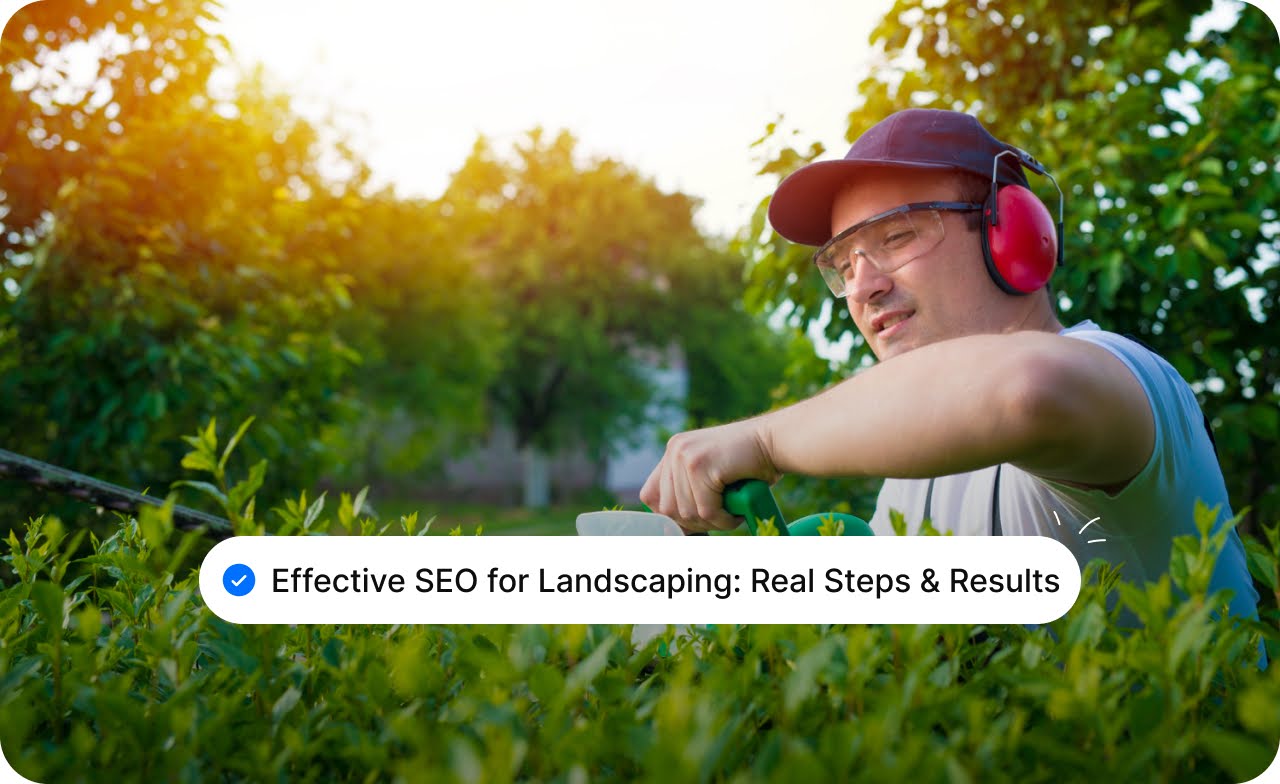
You might create stunning lawns and gardens week after week, yet still notice fewer calls than expected. Many landscaping businesses face this gap because people nearby search online for services but cannot find them. SEO for landscaping helps close that gap.
It means improving your website so Google understands what you do and shows your business when someone searches for phrases like “landscaper near me” or “garden design in [city].” The goal is to bring more visitors (called “traffic”) to your website and turn them into inquiries or booked jobs (known as “leads”).
With the right SEO approach, your business can stay visible to local homeowners already searching for the services you offer.
Why Landscaping SEO Matters for Every Local Business?
Every day, homeowners search online for help with things like patchy lawns, untrimmed trees, or outdoor makeovers. The businesses that show up first on Google get the call, while others lose out even if they do great work.
SEO for landscaping changes by making sure your business appears when nearby customers look for services you already offer. It is about showing up where people are already searching. When your website ranks high in search results, you earn visibility and trust before a customer even visits your page.
The more often your business appears online, the more it feels like a familiar and reliable choice to potential clients.
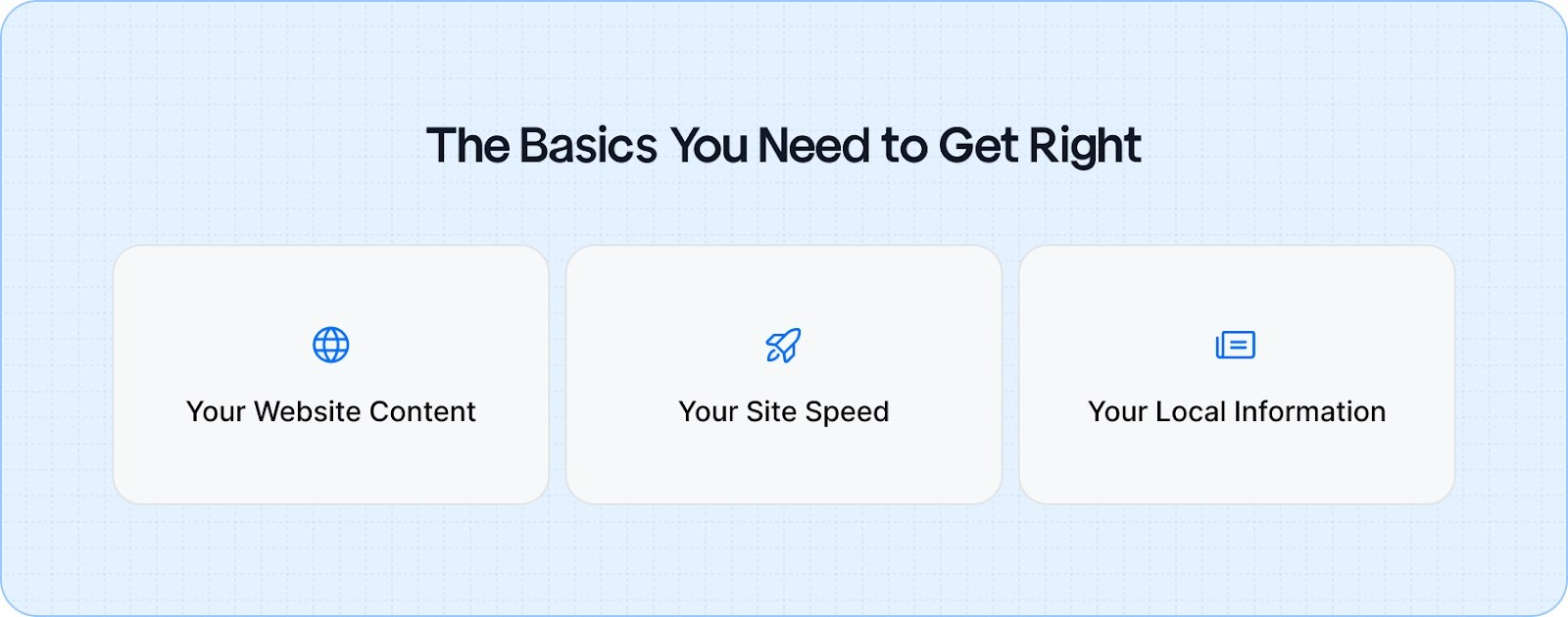
Before you spend a single dollar on tools or ads, three simple foundations decide how visible your landscaping business becomes online. When these are strong, every other marketing effort performs better.
Your website is your digital front yard. Service pages should clearly explain what you offer, from lawn care to stone patios, while a blog helps you share practical advice that earns trust.
A slow website turns visitors away before they even see your work. Fast-loading pages keep potential clients engaged and ready to contact you.
Your business name, address, and phone number (often called NAP) must match perfectly everywhere online, from Google to Facebook. This consistency helps search engines trust your business and rank it higher.

Your Google Business Profile is your digital storefront. To get found locally, ensure your profile is complete and accurate, add your business name, hours, and service areas. Upload real photos of recent projects to showcase your work.
Engage with every customer message and review to build trust, as Google values active businesses. The more complete and engaging your profile, the higher you'll rank when local customers search for your services.
Treat your Google profile like your shop sign on the internet. Add accurate details, your business name, working hours, and service areas. Upload photos from recent projects to show real results. Reply to every message and question, no matter how small. Google values engagement as much as customers do.
After each project, kindly ask clients to share their experience online. A few genuine reviews each month can lift your visibility more than any ad.

Reviews tell both Google and future customers that you are reliable. Always thank reviewers, even when the feedback is critical; it shows professionalism and care.
Search engines trust consistency. Make sure your details on directories like Yelp, Angi, and BBB match exactly, the same name, address, and phone number everywhere. Fixing old or incorrect information prevents confusion and builds credibility with search engines and potential customers alike.

If you serve multiple towns or suburbs, each one deserves its own spotlight online. A city page is simply a dedicated webpage for a specific location, for example, “Landscaping Services in Austin, TX.” It helps your business appear when someone nearby searches for that exact area.
A well-built city page speaks directly to the people in that area. When a homeowner in Austin or Dallas searches online, they find a page that mentions their neighborhood, showcases nearby projects, and highlights your experience close to home. This instantly builds familiarity and trust.
Here’s what every effective city page should include:
When you set up city pages the right way, each one quietly works for you, attracting customers from nearby cities even while you are busy on-site. Over time, they become a steady source of calls and new projects.
As one Reddit user points out, local SEO for landscaping businesses requires consistent updates to your Google Business Profile, location-specific landing pages, and accurate citations.
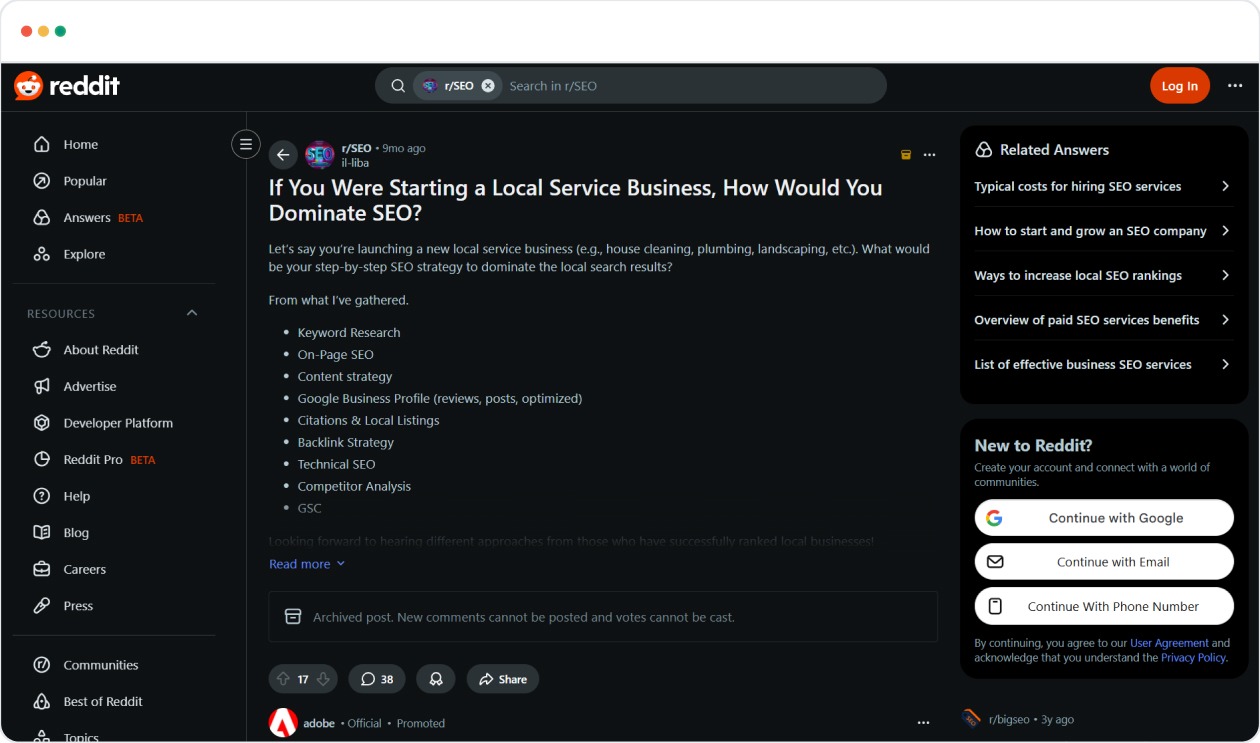
However, managing all these moving parts, while staying on top of client communications, can quickly become time-consuming.
That’s why many businesses, like yours, use solutions like Gushwork to automate follow-ups, streamline marketing tasks, and keep everything running smoothly, allowing you to focus on what you do best: delivering top-notch landscaping services.
You do not need fancy words or marketing tricks to attract customers. Share what you already know from the field, the kind of advice you give clients every day. When people see your expertise online, they start trusting your business before they even call.
This kind of content answers real questions, keeps you visible on Google, and positions your landscaping business as the local expert people turn to when they need help.
When someone clicks on your website, they decide within seconds whether to stay or leave. If pages take too long to load or look confusing, most visitors move on to the next landscaper, no matter how skilled you are. Your website should feel as smooth and easy as talking to you in person.
Here’s how to make that happen:
These small fixes can turn your website into a steady source of leads, quietly bringing in calls while you focus on finishing jobs. Yet, setting up and maintaining these details can take hours, time that could be spent growing your business.
When respected local websites talk about your business, Google treats it as a sign of real authority. These local backlinks act like digital referrals, proof that your company is active, trusted, and connected within the community. The more quality mentions you earn, the more Google prioritizes your business in local searches.
Strong mentions usually come from being visible in the right places, not from random outreach. Landscaping companies that stand out online often appear across trusted local sources, such as:
Each of these placements strengthens your reputation and gives Google more reasons to trust your brand. But getting them consistently requires strategy, identifying the right partners, building the right connections, and ensuring your mentions add measurable SEO value instead of noise.
You have already done the hard work, and your website is bringing people in. Now it needs to help them take the next step. Every second a visitor spends unsure of how to contact you is a missed opportunity. A well-designed website gently guides visitors from curiosity to action.
To make that happen, every detail should work together to build trust and make contact effortless:
These elements may look simple, but how they are placed, styled, and connected makes all the difference between a casual visitor and a confirmed client. Done right, small improvements here can double the number of inquiries your business receives each week.
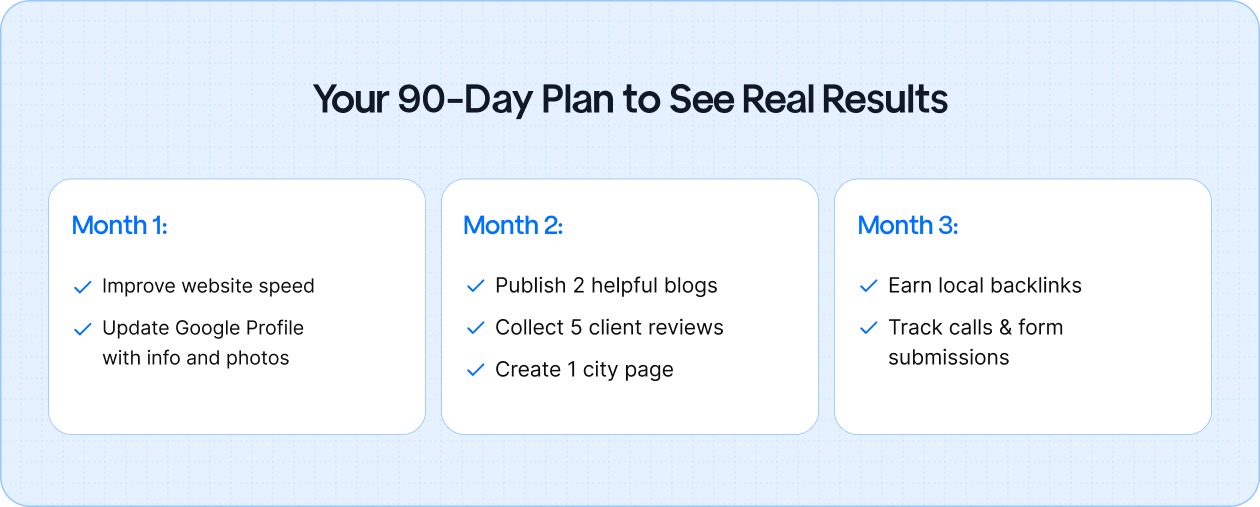
In just 90 days, your landscaping business can move from being invisible online to becoming the first name people call in your area. Here is how a structured plan unfolds when done right:
Every landscaping business grows at its own pace, but the right SEO plan follows a clear rhythm of effort, consistency, and return. Understanding your investment upfront helps you plan realistically and see steady progress.
The real difference lies in execution: staying consistent, tracking the right numbers, and using a system built for long-term results.
When your website appears at the right time, it earns trust before you even pick up the phone. Over time, that visibility turns into steady calls, project requests, and loyal customers.
But keeping that growth going takes consistency. Once your rankings improve, the real work begins: staying visible, following up with leads, and nurturing the ones who showed interest. That is where the right system makes all the difference.
Gushwork helps you keep your marketing running quietly in the background, managing follow-ups, automating outreach, and making sure no lead slips away while you are busy working on-site.
It turns your digital presence into a dependable engine that works around the clock, so your next client is already lined up when you finish the current job.
A1. Typically, you’ll begin to see clearer indicators, like more calls, more quoted jobs, or better ranking in local searches, within 3-6 months, if your site, local listings and content are consistently optimized. The real gains are built from regular work over time.
A2. For single-area businesses, budgeting around $500-$1,000/month is a reasonable start for foundational work. As you serve multiple cities or want to scale faster, budgets can rise toward $2,000-$3,000/month to cover wider reach, more content, and higher-authority links.
A3. GBP acts like your virtual storefront in Google Search and Maps. If everything, your business name, address, phone number, photos, and reviews, is accurate and visible, you’re far more likely to appear when people search for “landscaper near me.” A well-optimized GBP drives both visibility and trust.
A4. Yes, if you serve multiple towns, creating a dedicated page for each city helps you target those local searches. These pages should use the town’s name in the headline, list services you offer there, include local project photos, and include a clear call to action. This approach improves your chance of ranking in those specific areas.
A5. There’s no fixed number, but consistency wins. Asking happy clients right after each job and getting a steady stream of fresh reviews signals to both people and Google that you’re active and trustworthy. Even a handful of well-timed reviews each month can improve local visibility and lead flow.
A6. Not really. A slow or awkward mobile site often loses visitors before they find what they came for. For local services like landscaping, most searches happen on phones; if your site takes too long to load or isn’t mobile-friendly, you may lose a potential job. Technical optimization is foundational.
A7. Track measurable outcomes: number of phone calls, form-fill inquiries, bookings or quote requests, and ranking improvements in your service areas. Use a simple dashboard to compare before and after. When you can link actions (new city pages, reviews, links) to real calls or booked jobs, you know the system works.

Running a construction company today means competing both on job sites and online. When property owners or developers need a contractor, they turn to Google before making a call.

This guide simplifies SEO for construction companies, showing how you can rank higher on Google, earn client trust, and turn online searches into consistent project inquiries.
Two construction businesses can have the same skills, experience, and satisfied clients, yet one consistently receives project inquiries online while the other waits for word-of-mouth referrals. The reason behind this gap is simple: visibility.
That visibility comes from SEO, or Search Engine Optimization, the process of improving your website so that Google recommends it when people search for services like “commercial builders near me” or “home renovation contractors in [city].” It’s how potential clients find you before they ever make a call.
When SEO is done right, your website becomes a digital sales tool that attracts qualified prospects day and night, helping you secure more projects without increasing your marketing spend.

Most construction companies rely on word-of-mouth, but clients now search online before choosing who to hire. When someone looks up “office builder near me” or “home renovation in Chicago,” Google decides which businesses to display first. The ones that appear there get the calls, the quotes, and the contracts.
To earn that spot, start with the foundation, your Google Business Profile. Treat it like your digital storefront:
Once your profile is ready, strengthen it:
When your business details are complete, accurate, and active, your profile works as your digital word-of-mouth, visible to every client searching in your area.
Your website is often the first impression before a client ever makes a call. It should feel like walking into your office, clear, professional, and reassuring. A strong construction website answers three questions instantly:
Build separate service pages for every area you cover, such as residential construction, commercial projects, roofing, or renovations. Each page should explain your process, scope of work, and what makes your approach reliable.
Add project photos and short timelines to show what clients can expect. Real images and testimonials from previous builds build credibility far faster than stock visuals or generic claims.
Performance matters too. Many prospects browse on mobile, so your site must load quickly and display seamlessly across all devices. A slow or confusing layout can cost you inquiries even before someone reads your offer.
Guide visitors naturally with clear call-to-action buttons like “Request a Quote” or “Call Now.” The easier you make it for someone to connect, the higher your chances of turning that visitor into a confirmed client.
Every completed project tells a story of challenges solved, timelines met, and trust earned. Yet many construction companies leave those stories untold, hidden in photo folders or client emails. When shared the right way, each project can bring in your next big client.
Create dedicated project pages that walk potential clients through your work. Start with the client’s challenge, maybe an outdated office space, a leaking roof, or a commercial expansion. Then explain how you approached it:
These project pages do more than display your work; they show proof of reliability, quality, and experience. Plus, when written naturally, they include local keywords that help you rank higher on Google without forced optimization.
The more specific and authentic your project stories are, the more likely potential clients will see themselves in them and reach out for their next build.
Most potential clients start with questions, not quotes. They want to know how long a renovation might take, what permits they’ll need, or how much a new warehouse could cost. When your website provides those answers, you become their first trusted source, long before they decide who to hire.
Use your blog or FAQ section to address real, everyday client questions, such as:
This type of content serves two purposes. It helps people feel informed, and it helps Google recognize your website as an authority in your field. The more helpful and consistent your content, the higher your chances of appearing when someone searches for construction help in your area.
When clients find clear, honest information on your site, they associate your business with credibility and expertise. That trust often turns a reader into your next inquiry.
Every time another website talks about your company and links to your site, it acts like a digital referral. Just as a satisfied client recommending you to a neighbor builds trust in the real world, backlinks from credible sources build trust online, both with potential clients and with Google.
These mentions tell search engines that your business is legitimate, respected, and worth showing to people searching for contractors in your area. The goal is to earn a few links that truly matter and not collect hundreds.
Start with connections you already have:
Each mention strengthens your reputation online and helps you rank higher in local searches. Focus on earning authentic, local, and industry-relevant links; they’re far more valuable than random listings that offer no real connection to your work.
You would never hand over a building plan with weak foundations; the same rule applies to your website. Behind every great-looking site, there’s solid technical work that makes it fast, secure, and easy for both visitors and Google to navigate.
Website speed is your first test. If your pages take longer than three seconds to load, potential clients often leave before they even see your projects. Compress large images, especially high-resolution site photos, to keep performance smooth without losing quality.
Next comes security and structure. Use HTTPS to protect visitor data; it builds confidence and signals to Google that your site is trustworthy. Then, check how your website looks and works on different devices. A slow or broken mobile layout can cost you valuable leads, since most people browse on their phones.
Finally, make navigation effortless. Clear menus, logical page links, and easy-to-find contact buttons help visitors and Google understand your website better. The simpler the journey, the higher the chances clients stay and reach out.
Trust is the foundation of every successful construction project, and your online presence should reflect the same strength. Before a client decides to call, they look for signals that prove your credibility. Google does too.
Start by giving both clients and search engines solid proof of who you are and what you stand for:
These proof points help Google understand your authority and reassure potential clients that your company delivers exactly what it promises. When visitors feel that credibility, they stay longer, engage deeper, and reach out faster.
You would never pour concrete without checking the measurements first; the same logic applies to your marketing. Tracking results shows which efforts actually bring clients through the door and which ones need adjustment.
You don’t need expensive software to do it. A few free tools can tell you almost everything you need to know:
By checking these numbers once or twice a month, you’ll know exactly where your next client is coming from. That insight helps you spend time and money on what delivers real results.
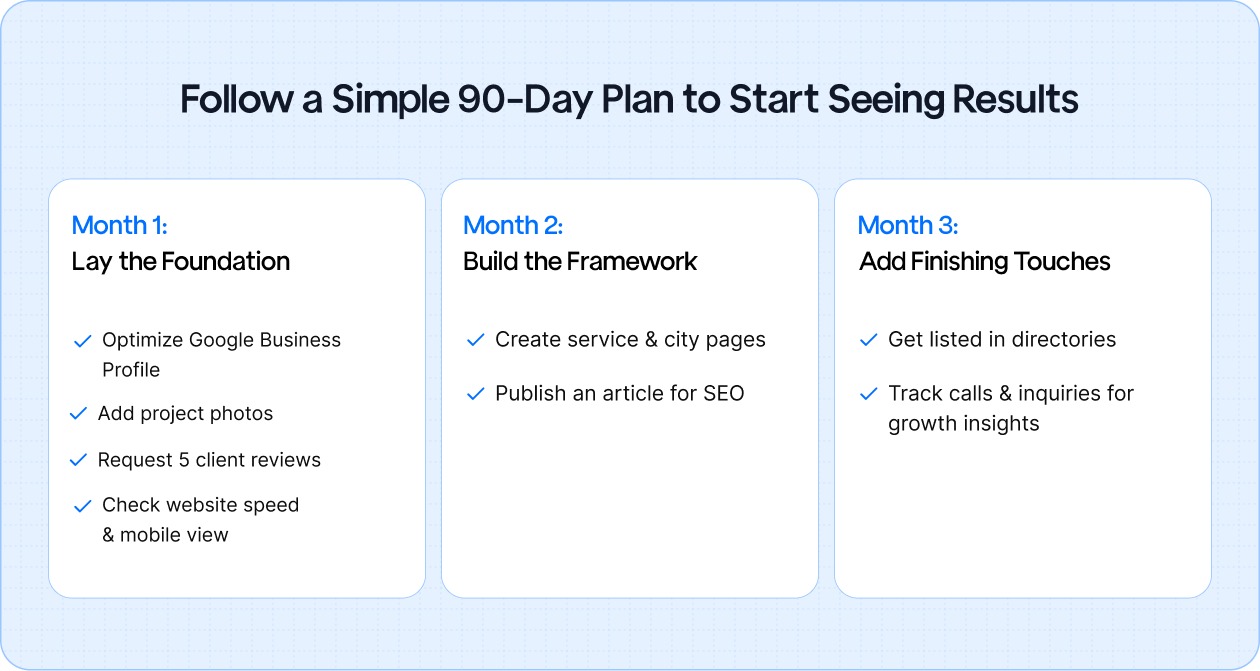
Every strong build starts with a clear timeline; SEO is no different. When you treat your online presence like a project plan, you can measure progress, track milestones, and see steady growth within just 90 days.
Your first month is all about groundwork.
Now that you’re visible, strengthen your structure.
The final stage focuses on visibility and measurement.
By the end of this plan, you’ll have a digital presence strong enough to attract clients consistently, and data to show what’s working best.
SEO lays that groundwork, helping people find you, trust you, and choose you long before they ever pick up the phone.
When your listings are optimized, your content speaks to real client needs, and your projects are showcased with pride, your website becomes more than a digital presence; it becomes your strongest business partner. Over time, that steady visibility brings in consistent leads, repeat clients, and the kind of growth that keeps your schedule full year-round
A1. SEO (Search Engine Optimization) for construction companies refers to optimizing your website and online presence so your business appears when people search for services like yours, such as “commercial builder in Chicago” or “home renovation contractor near me.” It matters because most clients now begin with a search online, and strong SEO means you get found first rather than being overlooked.
A2. Results vary depending on competition, location, and how well your site is optimized. In many cases, initial improvements, such as better visibility and more inquiries, can start within 3 to 6 months if foundational steps (local listings, website speed, content) are completed. Larger-scale visibility gains often take 6–12 months.
A3. Instead of broad terms like “construction company,” you should focus on service + location keywords, such as “roof replacement Peoria IL” or “industrial build-out Dallas TX.” These phrases reflect what potential clients actually search for and carry less competition while attracting more relevant leads.
A4. Yes. If your website takes too long to load or doesn’t work well on mobile devices, visitors will leave, and Google will penalize you. For construction companies, often use image-heavy project galleries, making sure the website loads fast on phones and tablets is critical to retaining leads and ranking better.
A5. Very beneficial. Your Google Business Profile (GBP) gives you visibility in location-based searches and map results. Reviews help build trust with clients and send positive signals to Google about your reliability and relevance. A good review count + complete profile + photos = higher local ranking chance.
A6. The most effective content answers real client questions, such as “How much does a basement renovation cost in [city]?”, “What permits are needed for commercial construction in [state]?”, or “What’s the timeline for tenant improvements in a retail build-out?” This type of helpful, localized content drives qualified traffic and builds your authority.
A7. Yes, and it’s a key part of building credibility online. Good backlink sources include local business associations, suppliers or manufacturers listing you as a contractor partner, directories specific to construction, and local press about completed projects or awards. The quality and relevance of the linking site matter more than quantity.
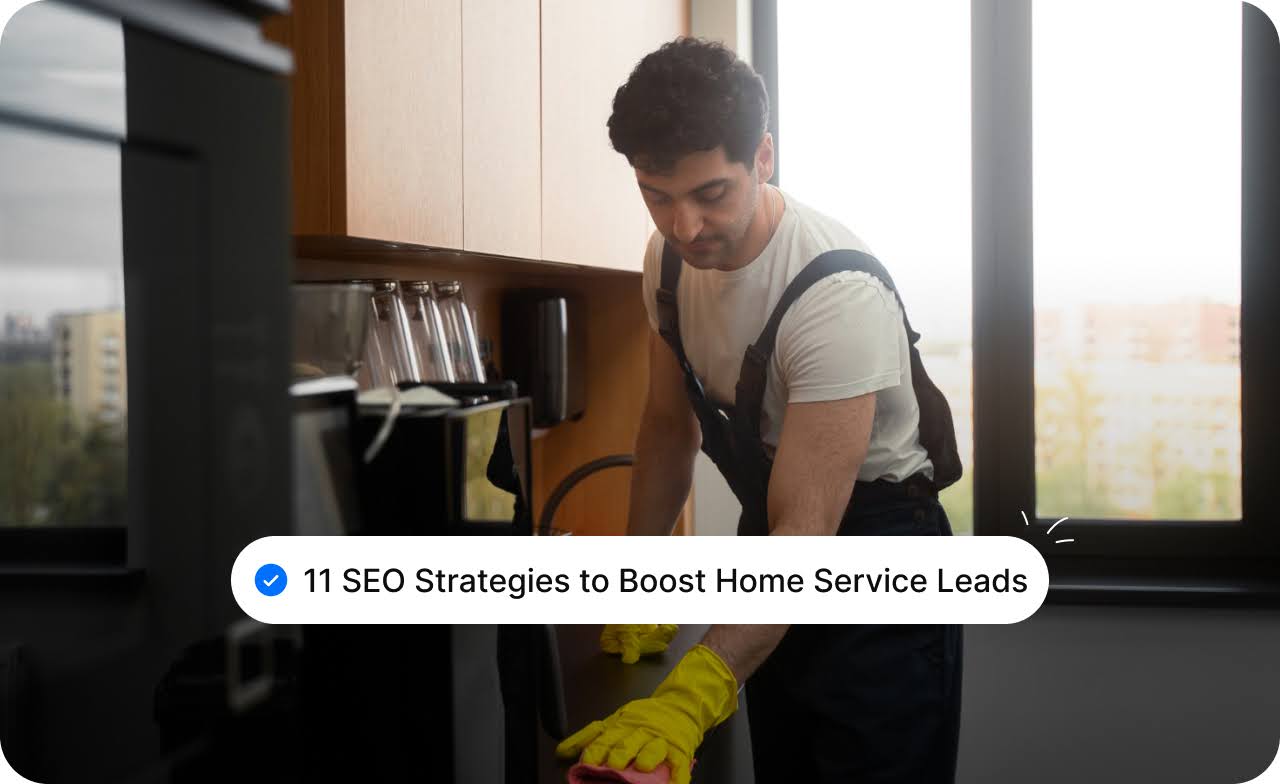
A homeowner spots a water stain spreading across the ceiling. Another feels warm air instead of cool from the vents. Within minutes, they search online for help, and the first few businesses they see get the job. The rest are forgotten.
That single online search decides who wins new business each day. No glossy brochures or billboards can match the influence of a simple local search that connects need with nearby expertise.
SEO for home services helps your business appear at that decisive moment, right where customers are looking for solutions. It builds visibility, trust, and authority so that your expertise is seen first and chosen fast.
This article breaks down proven strategies to strengthen your online presence, earn consistent leads, and build a brand that your local community recognizes instantly.
Homeowners rarely spend time comparing endless options online. When a pipe bursts or an outlet stops working, they click on one of the first businesses they see.
That one behavior shapes the success of every home service company today.
Home services SEO ensures your business appears right when someone needs help, helping you win the job before competitors are even noticed.
In a Reddit thread, users agreed that while anyone can handle basic SEO, true progress comes from consistent execution and data-backed strategy. Experienced professionals bring structure, save time, and apply insights that DIY methods often miss.
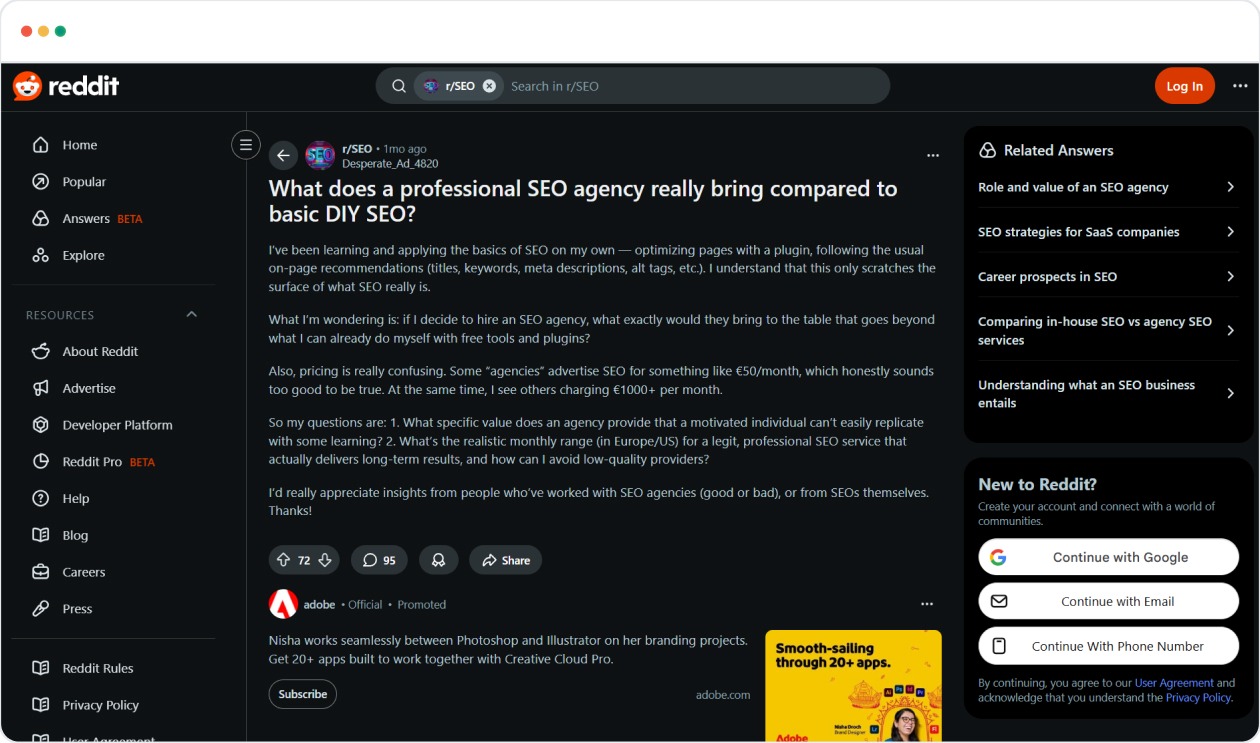
For home service providers, this highlights the value of systems that track performance and refine what works, exactly what expert-managed solutions like Gushwork help you achieve.
You already know SEO shapes how customers find and choose your services. The next step is applying it with structure. The following strategies focus on practical execution, improving visibility, building credibility through local signals, and ensuring every click has a clear path to conversion.
Each one is designed to make your marketing system measurable, consistent, and ready to drive real calls, not vanity metrics.
For local contractors, your Google Business Profile (GBP) is more influential than your website. It is the first impression most customers see.
Steps to optimize your profile:

Keywords are the bridge between what you offer and what customers search for. Yet many contractors guess rather than analyze.
Use data-backed insights to target what truly converts:
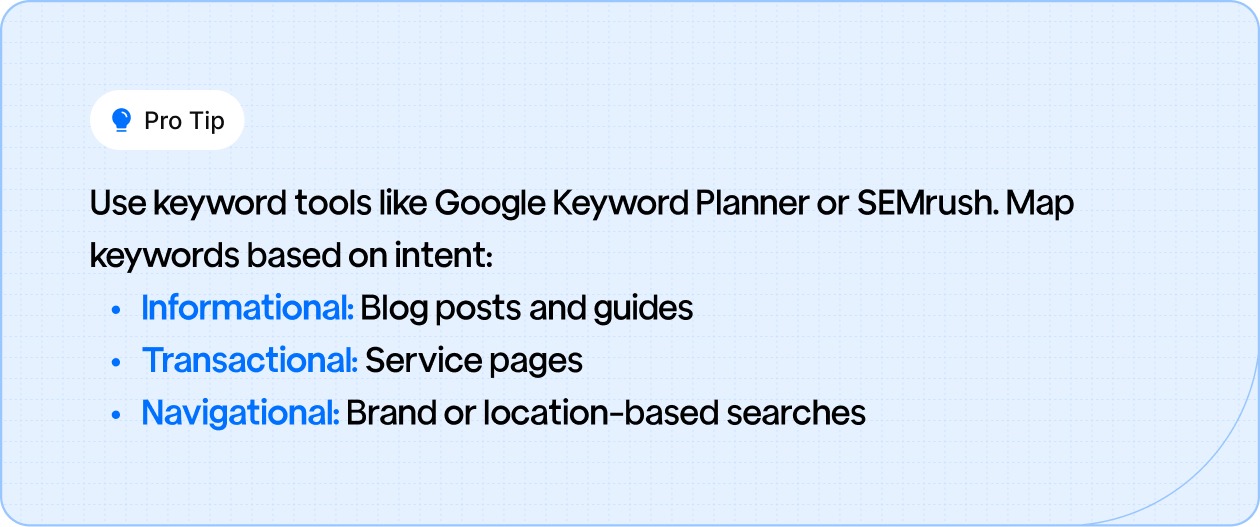
This ensures every page matches a real customer intent.
Your service pages are digital storefronts; they must build confidence in seconds.
Each page should include:
Add schema markup (Service, Review, FAQ) so Google understands your content better.
Inconsistent business details across directories confuse both Google and potential customers.
Ensure uniformity across your Name, Address, and Phone Number (NAP):
Consistency builds trust, and trust improves ranking authority.
Reviews shape perception before customers even click your website. Businesses with steady, positive reviews enjoy higher visibility and conversion rates.
Effective ways to collect and manage reviews:
Customers engage with businesses that understand their neighborhood realities.
Examples of valuable local content:
Ideas to add depth:
Educational content signals authority while improving search rankings.
A backlink from a trusted local source acts as a vote of confidence for your business.
High-value backlink opportunities:
Avoid irrelevant or spammy link exchanges; they harm credibility more than they help.
Half of your potential customers leave if a page takes longer than 3 seconds to load.
Technical must-haves:
When people search for cost-related terms, they are already close to hiring.
How to win these searches:
Transparency attracts serious buyers and improves dwell time on your site.
Without data, you can’t tell which effort drives results.
Tracking essentials:
Homeowners’ search behavior evolves constantly. The key is adapting faster than competitors.
Modern tactics that elevate your SEO game:
Innovation, paired with consistency, keeps your business visible and trusted year-round.
Every homeowner’s search starts with a moment of need, a dripping pipe, a flickering light, or a faulty AC that suddenly gives out. What happens next depends on how visible, trusted, and ready your business is to respond.
That’s the power of SEO for home services. It turns those small, urgent searches into real opportunities, steady leads, stronger visibility, and lasting customer relationships.
Each review, click, and optimized page builds a digital reputation that keeps working long after the job is done.
But consistent results need consistent systems.
A1. Home service businesses operate with location-based demand and immediate need signals. Unlike broader ecommerce, the focus is on appearing when someone types “emergency plumber near me” or “AC repair in [city]”. That means optimizing for service + area + urgency, managing your local profile, and ensuring your website converts inquiries into jobs. The faster you show up and the clearer your offer appears, the higher your chance of booking the job.
A2. Results depend on your current state: website quality, profile optimization, reviews, and local competition. Many home service businesses see improvements in visibility and incoming leads within 3-6 months if they maintain consistent SEO work (keywords, citations, reviews). Full impact, higher rankings, steady calls, booked jobs, often take 6-12 months, especially in competitive markets.
A3. It’s risky to skip them. Local citations establish proof of your business’s legitimacy for search engines and potential customers. Consistent listings across directories (name, address, phone) reinforce your presence in local searches. Even if your website is strong, missing or inconsistent directory listings can hold you back from top local pack rankings.
A4. Target keywords that reflect:
Segment these by intent: informational (blogs), commercial (service pages), and transactional (contact/quote). That way, you match what your potential customers are searching for and whether they’re ready to act.
A5. Yes, reviews are a strong trust signal for both search engines and humans. A business with many high-quality recent reviews appears more credible and has a higher chance of appearing in the local map pack. Responding to reviews also shows engagement and builds trust. Regular positive reviews can improve local visibility and conversion rates.
A6. No. Paid ads generate leads, but stop when the budget stops. SEO builds an owned presence that drives leads over time at a lower incremental cost. For a home service business, SEO means your organic presence will serve you when people search, not just when you turn the ad budget on. Combining both gives you the best coverage: paid for immediate triggers, SEO for sustained visibility.
A7. Some vital technical items include:
Fixing these improves user experience, supports search visibility, and helps convert site visits into bookings.

Some days, the phone rings because a past client remembered your work. Other times, a neighbor recommends you after seeing your truck outside their home. Those moments still matter. But not every new project comes from word-of-mouth anymore.
Contractor marketing steps in to keep that momentum going, so you’re visible, credible, and ready when someone starts searching for help online. It bridges the gap between reputation and reach, helping you turn recognition into steady, reliable business.
This guide walks you through practical ways to make that happen, without complicated jargon or wasted effort.
Your website is often the first time someone meets your business. It should look professional, load quickly, and answer one question immediately: “Can this contractor help me?”
To make that happen:
In marketing terms, traffic refers to visitors who come to your site, while leads are those who contact you. A well-built site turns visitors into paying customers, quietly, every day.
Your Google Business Profile (GBP) is your online business card. When someone types “contractor near me,” it decides if your name shows up.

Make sure it includes:
Google rewards active profiles, so reply to every review and post updates regularly.
Local SEO connects you to clients in your service area, people searching for help right now.

To strengthen your local visibility:
When marketers mention quality traffic, they mean visitors who are actually interested in hiring you, not random browsers. That’s the goal of local SEO.
If your homepage tries to cover everything, it converts nothing. Give each service its own page, “Roof Repair,” “Bathroom Remodeling,” or “Deck Installation.”
These focused pages help:
Paid ads help you appear exactly when people need your service.
A balanced mix builds immediate leads and long-term visibility.
Running ads without tracking is like working without a measuring tape.
Tracking tools show:
This clarity lets you stop guessing and focus your budget on results.
Homeowners do research before they decide. Sharing your knowledge positions you as a trusted pro.
Write short blogs or guides answering questions like:
This kind of content builds familiarity. When they finally need help, they’ll remember who gave them real answers.
Video gives your business a face. Show short clips of your team at work, time-lapse transformations, or quick maintenance tips.
Post them on:
People trust what they can see, and video builds that trust instantly.
Your past clients are your best marketers.

Reviews are digital word-of-mouth, and the more you collect, the stronger your online reputation becomes.
When clients are happy, they naturally talk about you, giving them a reason to do it more.
It keeps relationships strong and your client base growing without relying solely on ads.
Following up shows care, and it brings repeat business. Use automation tools to send:
A CRM (Customer Relationship Management tool) can handle all of this quietly while you focus on work.
Your potential clients scroll through social media every day. Be where they are.
Consistency builds familiarity, and familiarity builds trust, the first step to getting hired.
Collaboration opens new doors. Work with real estate agents, designers, and suppliers who already serve your target homeowners.
A simple referral agreement or mutual promotion can bring steady, high-quality leads without extra spending.
Numbers tell the truth; marketing opinions can’t. Keep an eye on:
Review these monthly and tweak what’s not working. It’s like fine-tuning a tool; small adjustments can bring sharper results.
Your time is best spent building, not juggling admin work. AI tools can handle repetitive marketing tasks such as:
It’s like having a reliable site manager for your marketing, working even when you’re not.
Every project starts with a plan, a set of tools, and a promise to deliver quality. Marketing should work the same way. The best systems don’t replace your effort; they support it, keeping your name visible, your leads organized, and your business running even when you’re out in the field.
When done right, contractor marketing feels less like “promotion” and more like momentum. Each review, video, and follow-up adds to your reputation.
Each ad and email strengthens the connection between you and your next customer. It’s about building a rhythm where new work finds you, not the other way around.
That’s exactly what Gushwork helps you achieve.
A1. Contractor marketing covers all the activities you use to find new clients, keep past ones engaged, and encourage repeat business. That means your website, online listings, reviews, ads, content, and follow-up systems all play a part.
A2. A qualified lead in a contracting business is someone who: (a) needs the specific service you offer, (b) is located in your service area, and (c) is ready to act within a reasonable timeline. Tracking leads helps you focus on these instead of chasing low-probability prospects.
A3. There’s no one-size-fits-all number, but many sources suggest contractors allocate a percentage of revenue (for example, 7-10%) to marketing. The key is tracking your spending vs. the business you win and adjusting as you learn.
A4. Separate pages allow you to speak directly to each kind of customer need. Someone searching “deck installation” will find your deck page faster. This improves usability for the visitor and relevance for search engines, which means better ranking and more relevant leads.
A5. Organic search means your website appears naturally in search results based on relevance and quality (no direct payment for placement). Paid ads (such as Google or Meta) mean you pay to have your message shown. Both have value: organic builds long-term presence; paid ads get you in front of people now.
A6. Extremely important. Reviews act as digital word-of-mouth: they show prospects you’ve delivered on your promises. Referrals turn satisfied clients into sources of new business. Together, they reduce cost per lead and increase trust long before you speak with a homeowner.
A7. Yes, even with a modest budget, marketing can work if you focus on the right channels and track results. For example, start with optimizing your online listing, collecting reviews, and publishing one helpful article. As you get results, you invest more in ads or broader campaigns.





.svg)
.svg)
.svg)